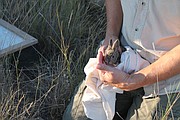A giant effort to save a tiny rabbit
SAGEBRUSH FLAT — Jon Gallie clutches a white pillowcase like a bag and crouches down.
The pillowcase moves and squirms. There’s something inside that doesn’t want to be there.
He struggles with one hand to pull back the lid of a small temporary cage while keeping a tight grip on the pillow case with the other. It takes a little work. But finally, Gallie gets the cage lid open, and he pops in two sprigs of sagebrush.
“They’re not tame, and they aren’t instinctively wanting to be in our presence,” Gallie said of the creature wriggling in the bag.
And that’s a measure of success, Gallie added, since this rabbit’s ancestors were raised in a zoo, and were too used to human beings.
Time to transfer the squirming critter from the pillowcase to the cage.
It’s a tough task, slowly unrolling the pillowcase while trying not to let what’s inside escape. But Gallie, a wildlife biologist for the Washington Department of Fish and Wildlife who also heads the pygmy rabbit recovery program, is a master of this. Eventually, two tiny gray ears appear, followed by a head. Gallie bends over to take a closer look.
“This one’s got singed whiskers!” Gallie shouts.
“Woo hoo!” comes a distant cheer from biologist Brian Zinka.
Singed whiskers means this endangered Columbia Basin pygmy rabbit is one of the 32 survivors of a wildfire that destroyed a 10-acre breeding enclosure and killed about 70 other pygmy rabbits in early July.
Fish and Wildlife manages three other breeding enclosures, like the 4-acre fenced-in tract of sagebrush and scrub grass where Gallie and a number of other wildlife specialists, graduate and undergraduate students are catching pygmy rabbits to find out how healthy this community is.
While pygmy rabbits — small enough to fit in a person’s hand — are fairly widespread and numerous across the Western deserts and scrubland of the United States, the population in the Columbia Basin is isolated and has not adjusted well as much of its native habitat now grows wheat and barley.
“The Conservation Reserve Program has been one of the best things that has happened for the pygmy rabbit,” Gallie said.
The U.S. Department of Agriculture’s Conservation Reserve Program (CRP) allows farmers to take marginal land out of production for long periods of time and receive a payment, allowing the rabbit’s natural habitat to expand here on Sagebrush Flat.
The last pure-bred Columbia Basin pygmy rabbits died a decade ago. The species is currently viable because they have been crossbred with pygmy rabbits from Idaho and been carefully tended in these breeding enclosures and at the Portland Zoo.
It’s early morning work, catching rabbits, and everyone gets to work setting traps in front of rabbit burrows or carrying nets in the event they flush a rabbit out. The goal is to catch as many rabbits as they can, take samples of DNA, and then re-release them back into the enclosure, Gallie said.
“We do this a couple of times,” Gallie said. “But there are always rabbits you don’t find.”
While the pygmy rabbits have had a hard time breeding in captivity, they’ve been good rabbits in the wild, and Gallie said they have to move them around to make sure they don’t become too inbred.
“Once in here, they are free to make a choice,” Gallie said. “The genetics show that everyone spends a night in everyone else’s burrow.”
The hope is to have enough rabbits eventually to sustain the population without the help of the Fish and Wildlife department. Currently, about 100 pygmy rabbits live in the three remaining breeding enclosures, up from 16 known rabbits in the wild in 2001.
Until then, biologists and their students helpers will occasionally rise with the early summer sun, grab traps and nets, and stalk the sagebrush looking to catch their tiny prey — wildfire or not.
“Outside of salmon and the gray wolf, this is the largest single endangered species focus in the state,” Gallie said.





